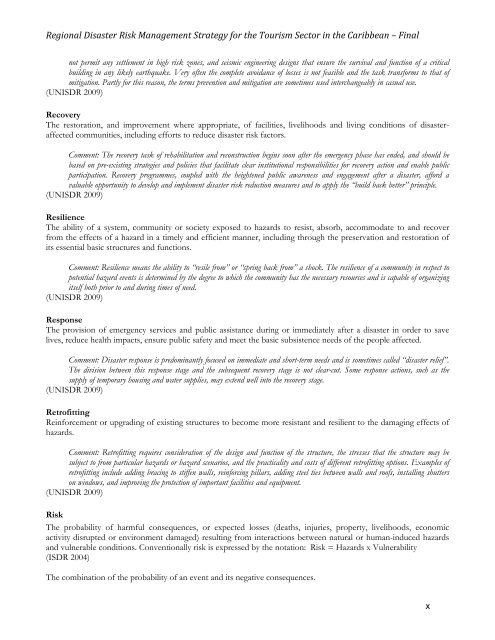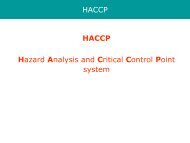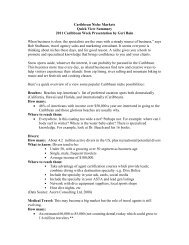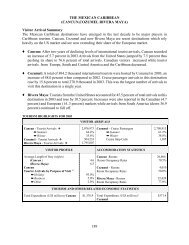Disaster Risk Management Strategy and Plan of Action - Caribbean ...
Disaster Risk Management Strategy and Plan of Action - Caribbean ...
Disaster Risk Management Strategy and Plan of Action - Caribbean ...
You also want an ePaper? Increase the reach of your titles
YUMPU automatically turns print PDFs into web optimized ePapers that Google loves.
Regional <strong>Disaster</strong> <strong>Risk</strong> <strong>Management</strong> <strong>Strategy</strong> for the Tourism Sector in the <strong>Caribbean</strong> – Final<br />
not permit any settlement in high risk zones, <strong>and</strong> seismic engineering designs that ensure the survival <strong>and</strong> function <strong>of</strong> a critical<br />
building in any likely earthquake. Very <strong>of</strong>ten the complete avoidance <strong>of</strong> losses is not feasible <strong>and</strong> the task transforms to that <strong>of</strong><br />
mitigation. Partly for this reason, the terms prevention <strong>and</strong> mitigation are sometimes used interchangeably in casual use.<br />
(UNISDR 2009)<br />
Recovery<br />
The restoration, <strong>and</strong> improvement where appropriate, <strong>of</strong> facilities, livelihoods <strong>and</strong> living conditions <strong>of</strong> disasteraffected<br />
communities, including efforts to reduce disaster risk factors.<br />
Comment: The recovery task <strong>of</strong> rehabilitation <strong>and</strong> reconstruction begins soon after the emergency phase has ended, <strong>and</strong> should be<br />
based on pre-existing strategies <strong>and</strong> policies that facilitate clear institutional responsibilities for recovery action <strong>and</strong> enable public<br />
participation. Recovery programmes, coupled with the heightened public awareness <strong>and</strong> engagement after a disaster, afford a<br />
valuable opportunity to develop <strong>and</strong> implement disaster risk reduction measures <strong>and</strong> to apply the “build back better” principle.<br />
(UNISDR 2009)<br />
Resilience<br />
The ability <strong>of</strong> a system, community or society exposed to hazards to resist, absorb, accommodate to <strong>and</strong> recover<br />
from the effects <strong>of</strong> a hazard in a timely <strong>and</strong> efficient manner, including through the preservation <strong>and</strong> restoration <strong>of</strong><br />
its essential basic structures <strong>and</strong> functions.<br />
Comment: Resilience means the ability to “resile from” or “spring back from” a shock. The resilience <strong>of</strong> a community in respect to<br />
potential hazard events is determined by the degree to which the community has the necessary resources <strong>and</strong> is capable <strong>of</strong> organizing<br />
itself both prior to <strong>and</strong> during times <strong>of</strong> need.<br />
(UNISDR 2009)<br />
Response<br />
The provision <strong>of</strong> emergency services <strong>and</strong> public assistance during or immediately after a disaster in order to save<br />
lives, reduce health impacts, ensure public safety <strong>and</strong> meet the basic subsistence needs <strong>of</strong> the people affected.<br />
Comment: <strong>Disaster</strong> response is predominantly focused on immediate <strong>and</strong> short-term needs <strong>and</strong> is sometimes called “disaster relief”.<br />
The division between this response stage <strong>and</strong> the subsequent recovery stage is not clear-cut. Some response actions, such as the<br />
supply <strong>of</strong> temporary housing <strong>and</strong> water supplies, may extend well into the recovery stage.<br />
(UNISDR 2009)<br />
Retr<strong>of</strong>itting<br />
Reinforcement or upgrading <strong>of</strong> existing structures to become more resistant <strong>and</strong> resilient to the damaging effects <strong>of</strong><br />
hazards.<br />
Comment: Retr<strong>of</strong>itting requires consideration <strong>of</strong> the design <strong>and</strong> function <strong>of</strong> the structure, the stresses that the structure may be<br />
subject to from particular hazards or hazard scenarios, <strong>and</strong> the practicality <strong>and</strong> costs <strong>of</strong> different retr<strong>of</strong>itting options. Examples <strong>of</strong><br />
retr<strong>of</strong>itting include adding bracing to stiffen walls, reinforcing pillars, adding steel ties between walls <strong>and</strong> ro<strong>of</strong>s, installing shutters<br />
on windows, <strong>and</strong> improving the protection <strong>of</strong> important facilities <strong>and</strong> equipment.<br />
(UNISDR 2009)<br />
<strong>Risk</strong><br />
The probability <strong>of</strong> harmful consequences, or expected losses (deaths, injuries, property, livelihoods, economic<br />
activity disrupted or environment damaged) resulting from interactions between natural or human-induced hazards<br />
<strong>and</strong> vulnerable conditions. Conventionally risk is expressed by the notation: <strong>Risk</strong> = Hazards x Vulnerability<br />
(ISDR 2004)<br />
The combination <strong>of</strong> the probability <strong>of</strong> an event <strong>and</strong> its negative consequences.<br />
x

















